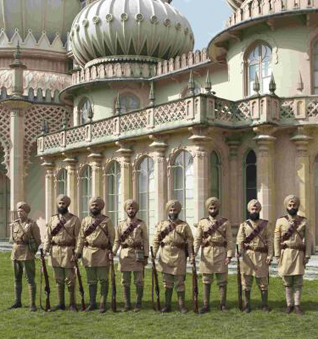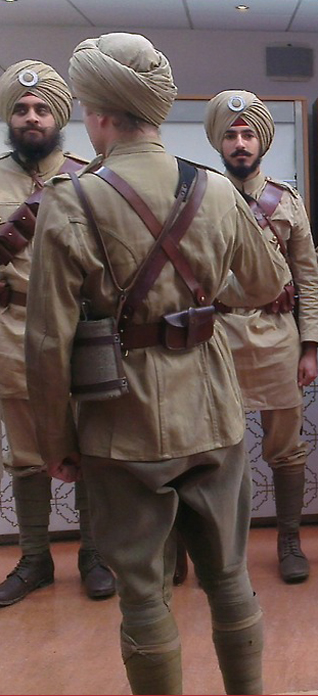Current Events
Great- Great- Grandson of Sikh WWI Hero Joins Memorial at National Army Museum, Brighton
JESSICA STAUFENBERG
Descendants of Sikh soldiers of the British Indian Army, including a Brighton student, arrived in full military uniform at the Royal Pavilion and discovered its role as a hospital during the First World War.
From December 1914 – February 1916, the Royal Pavilion was converted from a palace into a hospital for wounded Sikh and other Indian soldiers who had fought alongside the British.
In an outreach project run by the National Army Museum, descendants and volunteers represented a Sikh regiment at the Royal Pavilion on Saturday, September 13, 2014.
Volunteer and Brighton student Kuljit Singh Sahota, 21, of Sussex Square, described how it feels to represent the soldiers in uniform: “You can’t find the words for it.
"It’s a responsibility, they were really respected for what they did.”
The project, which represents the 15th Ludhiana Sikhs regiment of the British Indian Army, helped Kuljit Singh stumble across more information about his great great grandfather.
He said: “I never knew he came to Brighton. I didn’t intend to study in Brighton, it’s like fate that he was there and I am here now.
“I didn’t even know he was Subedar, the Major, of the 15th Ludhiana Sikhs we are representing until I did this project.”
Kuljit knew from his parents that his great grandfather, Manta Singh, was friends with the captain of his regiment, Robert Henderson.
When Capt Henderson was shot on the battlefield at the Battle of Neuve Chapelle, Kuljit's great great grandfather found a wheelbarrow and went to rescue him.
Kuljit said, “Whilst he was rescuing Robert Henderson he got shot himself and he was taken to Brighton to be treated, where he died from gangrene in his leg.
“Part of our faith is that it’s your human duty to stand up for wrongdoing. It’s an inspiration for me for the future.”
Capt Henderson took care of Subedar Manta Singh’s sons, who went on to fight alongside George Henderson, his own son, as allies in the Second World War. The two families are still in touch today.
An exhibition inside the Royal Pavilion, separate to the National Army Museum’s project, tells visitors more about the men who survived and those who did not recover during their stay in the hospital.
The town, nicknamed Doctor Brighton by the Maharajah of the Sikh Kingdom of Patiala, was often the soldiers’ first visit to the country they were fighting for.
Raminder Singh Uberoi, 37, of Woodridings Close, London, solicitor and a volunteer, wanted to get involved with the National Army Project to educate people.
He said: “I wanted to help say that we did contribute to the Great War, that we have a right to be here, we are such a close fabric to this society.
“We can help set an example to other Sikhs not to be fearful, but be proud of their heritage.
“At one event a grandmother asked to shake my hand, saying her father had told her to shake the hand of any Sikh she met.”
Concerned there is less understanding in today’s younger generation, Raminder Singh hopes the contribution of Sikh soldiers will be remembered through projects like this.
Julian Farrance, a curator at the National Army Museum, said raising awareness is central to War and Sikhs: Road to the Trenches, and was a big reason the museum secured Heritage Lottery Funding.
He said: “Nothing had ever been done like this before.
"It’s a completely new idea, for volunteers to represent the regiment in costume.”
The replica uniforms capture every detail of the regiment's dress, from boots to buttons to swords. The volunteers also received extensive training in drill, rifle-handling techniques and how to tie a military turban.
The National Army Museum volunteers said the response from the public at Brighton was really positive, and wished to thank the tour guides at the Royal Pavilion.
The Royal Pavilion exhibition on Sikh soldiers is on until early 2015 in Brighton, United Kingdom.
[Courtesy: The Argus. Edited for sikhchic.com]
October 3, 2014
Conversation about this article
1: Sandeep Singh Brar (Canada), October 03, 2014, 2:58 PM.
To learn more about how the Brighton Royal Pavilion was turned into a hospital for Sikh and Indian soldiers during WWI see the SikhMuseum.com online exhibit - Doctor Brighton's Pavilion.
2: Baldev Singh (Bradford, United Kingdom), October 03, 2014, 8:02 PM.
Salutations to the Sikhs and all others who gave their all for our basic freedoms!




